Effect of Whole Egg Liquid on Physicochemical, Quality, Fermentation and Sensory Characteristics of Yogurt
Abstract
1. Introduction
2. Materials and Methods
2.1. Materials and Reagents
2.2. Experimental Methods
2.2.1. Preparation of Egg Lactic Acid Milk
Liquid Whole Egg Processing Flow
Egg Lactic Acid Milk Fermentation Process
2.2.2. Fermentation Dynamics
2.2.3. Texture
2.2.4. Color
2.2.5. Water Holding Capacity
2.2.6. Electronic Nose (E-Nose)
2.2.7. Nutritional Value Determination
- 1 g of carbohydrates provides 17 KJ (4 Kcal);
- 1 g of lipids provides 38 KJ (9 Kcal);
- 1 g of protein provides 17 KJ (4 Kcal).
2.2.8. Rheological Properties
2.2.9. Total Lactic Acid Bacteria and Growth Dynamics
2.2.10. Sensory Evaluation
2.2.11. Statistical Analysis
3. Results and Discussion
3.1. Effect of Egg Addition on the Fermentation Kinetics of Yogurt
3.2. Effect of Egg Addition on the Texture of Yogurt
3.3. Effect of Egg Addition on the Color of Yogurt
3.4. Effect of Egg Addition on the Water Holding Capacity of Yogurt
3.5. Effect of Egg Addition on Yogurt Odor
3.6. Nutritional Value of the Fermented Milks
3.7. Effect of Egg Addition on the Rheological Properties of Yogurt
3.7.1. Apparent Viscosity
3.7.2. Elastic Modulus and Viscous Modulus
3.8. Total Lactic Acid Bacteria
3.9. Sensory Evaluation
3.10. Correlation Analysis
4. Conclusions
Author Contributions
Funding
Institutional Review Board Statement
Informed Consent Statement
Data Availability Statement
Conflicts of Interest
References
- Sidira, M.; Santarmaki, V.; Kiourtzidis, M.; Argyri, A.A.; Papadopoulou, O.S.; Chorianopoulos, N.; Tassou, C.; Kaloutsas, S.; Galanis, A.; Kourkoutas, Y. Evaluation of immobilized Lactobacillus plantarum 2035 on whey protein as adjunct probiotic culture in yoghurt production. LWT—Food Sci. Technol. 2017, 75, 137–146. [Google Scholar] [CrossRef]
- Godden, E.; Thornton, L.; Avramova, Y.; Dens, N. High hopes for front-of-pack (FOP) nutrition labels? A conjoint analysis on the trade-offs between a FOP label, nutrition claims, brand and price for different consumer segments. Appetite 2023, 180, 106356. [Google Scholar] [CrossRef]
- Mohammadi-Gouraji, E.; Soleimanian-Zad, S.; Ghiaci, M. Phycocyanin-enriched yogurt and its antibacterial and physicochemical properties during 21 days of storage. LWT 2019, 102, 230–236. [Google Scholar] [CrossRef]
- Oliveira, A.; Alexandre, E.M.C.; Coelho, M.; Lopes, C.; Almeida, D.P.F.; Pintado, M. Incorporation of strawberries preparation in yoghurt: Impact on phytochemicals and milk proteins. Food Chem. 2015, 171, 370–378. [Google Scholar] [PubMed]
- Dong, X.; Zhang, Y.Q. An insight on egg white: From most common functional food to biomaterial application. J. Biomed. Mater. Research. Part B Appl. Biomater. 2021, 109, 1045–1058. [Google Scholar] [CrossRef] [PubMed]
- Wang, Y.; Wang, J.; Shi, Y.; Ye, H.; Luo, W.; Geng, F. Quantitative proteomic analyses during formation of chicken egg yolk—ScienceDirect. Food Chem. 2021, 374, 131828. [Google Scholar] [CrossRef]
- Deng, C.; Shao, Y.; Xu, M.; Yao, Y.; Tu, Y. Effects of metal ions on the physico-chemical, microstructural and digestion characteristics of alkali-induced egg white gel. Food Hydrocoll. 2020, 107, 105956. [Google Scholar] [CrossRef]
- Amatayakul, T.; Sherkat, F.; Shah, N.P. Syneresis in set yogurt as affected by EPS starter cultures and levels of solids. Int. J. Dairy Technol. 2010, 59, 216–221. [Google Scholar]
- Lv, X.; Huang, X.; Ma, B.; Chen, Y.; Batool, Z.; Fu, X.; Jin, Y. Modification methods and applications of egg protein gel properties: A review. Compr. Rev. Food Sci. Food Saf. 2022, 21, 2233–2252. [Google Scholar] [CrossRef]
- Reis, R.D.; Caroline, L.; Facco, P.; Maria, E.; Flores, S.H.; Hickmann, S.; Rios, A.; Oliveira, A.D. Stability of functional compounds and antioxidant activity of fresh and pasteurized orange passion fruit (Passiflora caerulea) during cold storage. Food Res. Int. 2018, 106, 481–486. [Google Scholar] [CrossRef]
- Santo, A.P.d.E.; Perego, P.; Converti, A.; Oliveira, M.N. Influence of milk type and addition of passion fruit peel powder on fermentation kinetics, texture profile and bacterial viability in probiotic yoghurts. LWT—Food Sci. Technol. 2012, 47, 393–399. [Google Scholar] [CrossRef]
- Pelaes Vital, A.C.; Goto, P.A.; Hanai, L.N.; Gomes-Da-Costa, S.M.; de Abreu Filho, B.A.; Nakamura, C.V.; Matumoto-Pintro, P.T. Microbiological, functional and rheological properties of low fat yogurt supplemented with Pleurotus ostreatus aqueous extract. LWT—Food Sci. Technol. 2015, 64, 1028–1035. [Google Scholar]
- Tian, Y.; Zheng, S.; He, L.; Li, C.; Qiao, S.; Tao, H.; Wang, X.; Zeng, X. The effects of Trametes versicolor fermented Rosa roxburghii tratt and coix seed quild on the nutrition, sensory characteristics and physical and chemical parameters of yogurt. Food Chem. X 2023, 20, 100969. [Google Scholar] [CrossRef] [PubMed]
- Ozcan, T.; Horne, D.S.; Lucey, J.A. Yogurt made from milk heated at different pH values. J. Dairy Sci. 2015, 98, 6749–6758. [Google Scholar] [CrossRef] [PubMed]
- Fan, K.; Zhang, M.; Jiang, F. Ultrasound treatment to modified atmospheric packaged fresh-cut cucumber: Influence on microbial inhibition and storage quality. Ultrason. Sonochemistry 2019, 54, 162–170. [Google Scholar] [CrossRef] [PubMed]
- Benmeziane, F.; Belleili, I. An innovative approach: Formulation and evaluation of fermented oat milk using native yoghurt cultures. Meas. Food 2023, 12, 100113. [Google Scholar] [CrossRef]
- Giroux, H.J.; Britten, M.; Gentès, M.-C. Effects of milk fat substitution by canola oil on the properties of high-fat high-protein yoghurt. Int. Dairy J. 2023, 142, 105653. [Google Scholar] [CrossRef]
- APHA. Compendium of Methods of the Microbiological Examination of Foods, 4th ed.; American Public Health Association: Washington, DC, USA, 2001. [Google Scholar]
- Maier, R.M.; Pepper, I.L. Chapter 3—Bacterial Growth. In Environmental Microbiology, 3rd ed.; Pepper, I.L., Gerba, C.P., Gentry, T.J., Eds.; Academic Press: San Diego, CA, USA, 2015; pp. 37–56. [Google Scholar] [CrossRef]
- Ning, X.; Luo, Z.; Chen, Z.; Zhou, C.; Wang, L. Fortification of set yogurt with passion fruit juice: Effects on fermentation kinetics, physicochemical properties, and functionality. J. Dairy Sci. 2021, 104, 4084–4093. [Google Scholar] [CrossRef]
- Qiu, L.; Zhang, M.; Mujumdar, A.S.; Chang, L. Effect of edible rose (Rosa rugosa cv. Plena) flower extract addition on the physicochemical, rheological, functional and sensory properties of set. Food Biosci. 2021, 43, 101249. [Google Scholar] [CrossRef]
- Buchilina, A.; Aryana, K. Physicochemical and microbiological characteristics of camel milk yogurt as influenced by monk fruit sweetener. J. Dairy Sci. 2020, 104, 1484–1493. [Google Scholar] [CrossRef]
- Li, X.; Gao, Z.; Li, T.; Sarker, S.K.; Mu, Z. Effects of pH Values on Physicochemical Properties and Antioxidant Potential of Whey Protein Isolate-safflower Yellow Complexes. Food Sci. Technol. Res. 2018, 24, 475–484. [Google Scholar] [CrossRef]
- Sah, B.; Vasiljevic, T.; Mckechnie, S.; Donkor, O. Physicochemical, textural and rheological properties of probiotic yogurt fortified with fibre-rich pineapple peel powder during refrigerated storage. LWT—Food Sci. Technol. 2016, 65, 978–986. [Google Scholar]
- Fu, R.; Li, J.; Zhang, T.; Zhu, T.; Cheng, R.; Wang, S.; Zhang, J. Salecan stabilizes the microstructure and improves the rheological performance of yogurt—ScienceDirect. Food Hydrocoll. 2018, 81, 474–480. [Google Scholar] [CrossRef]
- Espírito-Santo, A.P.; Lagazzo, A.; Sousa, A.L.O.P.; Perego, P.; Converti, A.; Oliveira, M.N. Rheology, spontaneous whey separation, microstructure and sensorial characteristics of probiotic yoghurts enriched with passion fruit fiber. Food Res. Int. 2013, 50, 224–231. [Google Scholar] [CrossRef]
- An, J.; Zhang, M.; Lu, Q.; Zhang, Z. Effect of a prestorage treatment with 6-benzylaminopurine and modified atmosphere packaging storage on the respiration and quality of green asparagus spears. J. Food Eng. 2006, 77, 951–957. [Google Scholar] [CrossRef]
- Lin, Y.; Lin, H.; Lin, Y.; Zhang, S.; Chen, Y.; Jiang, X. The roles of metabolism of membrane lipids and phenolics in hydrogen peroxide-induced pericarp browning of harvested longan fruit. Postharvest Biol. Technol. 2016, 111, 53–61. [Google Scholar]
- Marand, M.A.; Amjadi, S.; Marand, M.A.; Roufegarinejad, L.; Jafari, S.M. Fortification of yogurt with flaxseed powder and evaluation of its fatty acid profile, physicochemical, antioxidant, and sensory properties. Powder Technol. 2020, 359, 76–84. [Google Scholar] [CrossRef]
- Kwon, H.C.; Bae, H.; Seo, H.G.; Han, S.G. Short communication: Chia seed extract enhances physiochemical and antioxidant properties of yogurt. J. Dairy Sci. 2019, 102, 4870–4876. [Google Scholar]
- Wang, R.; Zhang, M.; Mujumdar, A.S.; Jiang, H. Effect of salt and sucrose content on dielectric properties and microwave freeze drying behavior of re-structured potato slices. J. Food Eng. 2011, 106, 290–297. [Google Scholar] [CrossRef]
- Collard, K.M.; McCormick, D.P. A Nutritional Comparison of Cow’s Milk and Alternative Milk Products—ScienceDirect. Acad. Pediatr. 2020, 21, 1067–1069. [Google Scholar] [CrossRef]
- Jiménez-Flores, R. 11–Beverages Based on Milk Fat Globule Membrane (MFGM) and Other Novel Concepts for Dairy-Based Functional Beverages; Functional & Speciality Beverage Technology: Sawston Cambridge, UK, 2009; pp. 281–296. [Google Scholar]
- Turkmen, N.; Akal, C.; Özer, B. Probiotic dairy-based beverages: A review. J. Funct. Foods 2019, 53, 62–75. [Google Scholar] [CrossRef]
- Uduwerella, G.; Chandrapala, J.; Vasiljevic, T. Preconcentration of yoghurt base by ultrafiltration for reduction in acid whey generation during Greek yoghurt manufacturing. Int. J. Dairy Technol. 2017, 71, 71–80. [Google Scholar] [CrossRef]
- Hayashi, R.; Kawamura, Y.; Nakasa, T.; Okinaka, O. Application of High Pressure to Food Processing: Pressurization of Egg White and Yolk, and Properties of Gels Formed (Food & Nutrition). Agric. Biol. Chem. 1989, 53, 2935–2939. [Google Scholar]
- Mesquita, A.R.C.D.; Costa, C.R.R.; Frutuoso, J.; Pinheiro, I.O.; Mota, A.; Franchitti, A.A.; Ximenes, E.A. Activity of metabolites produced by new strains of Lactobacillus in modified de Man, Rogosa and Sharpe (MRS) medium against multidrug-resistant bacteria. Afr. J. Microbiol. Res. 2017, 11, 345–355. [Google Scholar]
- Fusco, V.; Fanelli, F.; Chieffi, D. Chapter 6—Milk and Dairy Products. In Food Safety Management, 2nd ed.; Andersen, V., Lelieveld, H., Motarjemi, Y., Eds.; Academic Press: San Diego, CA, USA, 2023; pp. 85–115. [Google Scholar] [CrossRef]

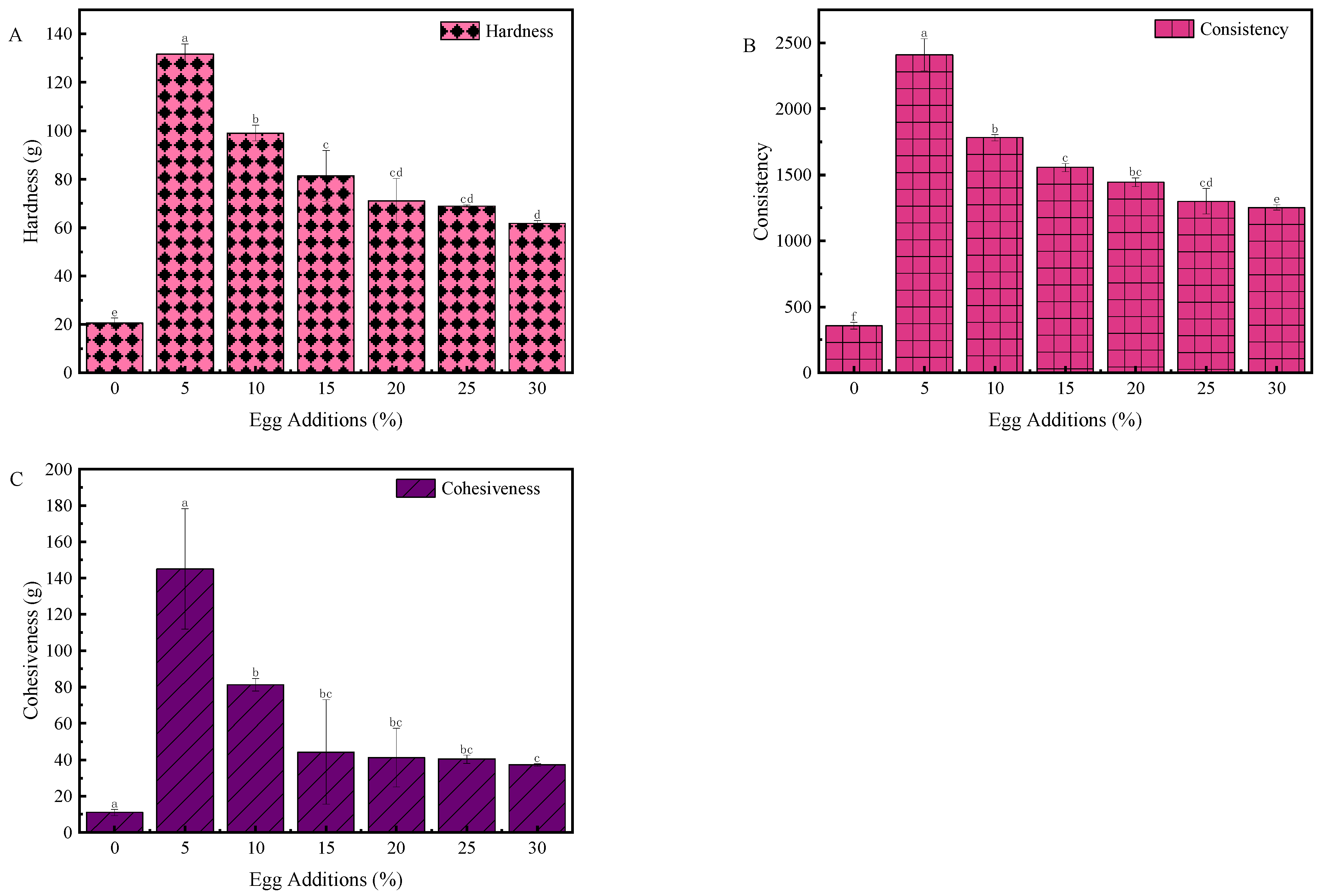
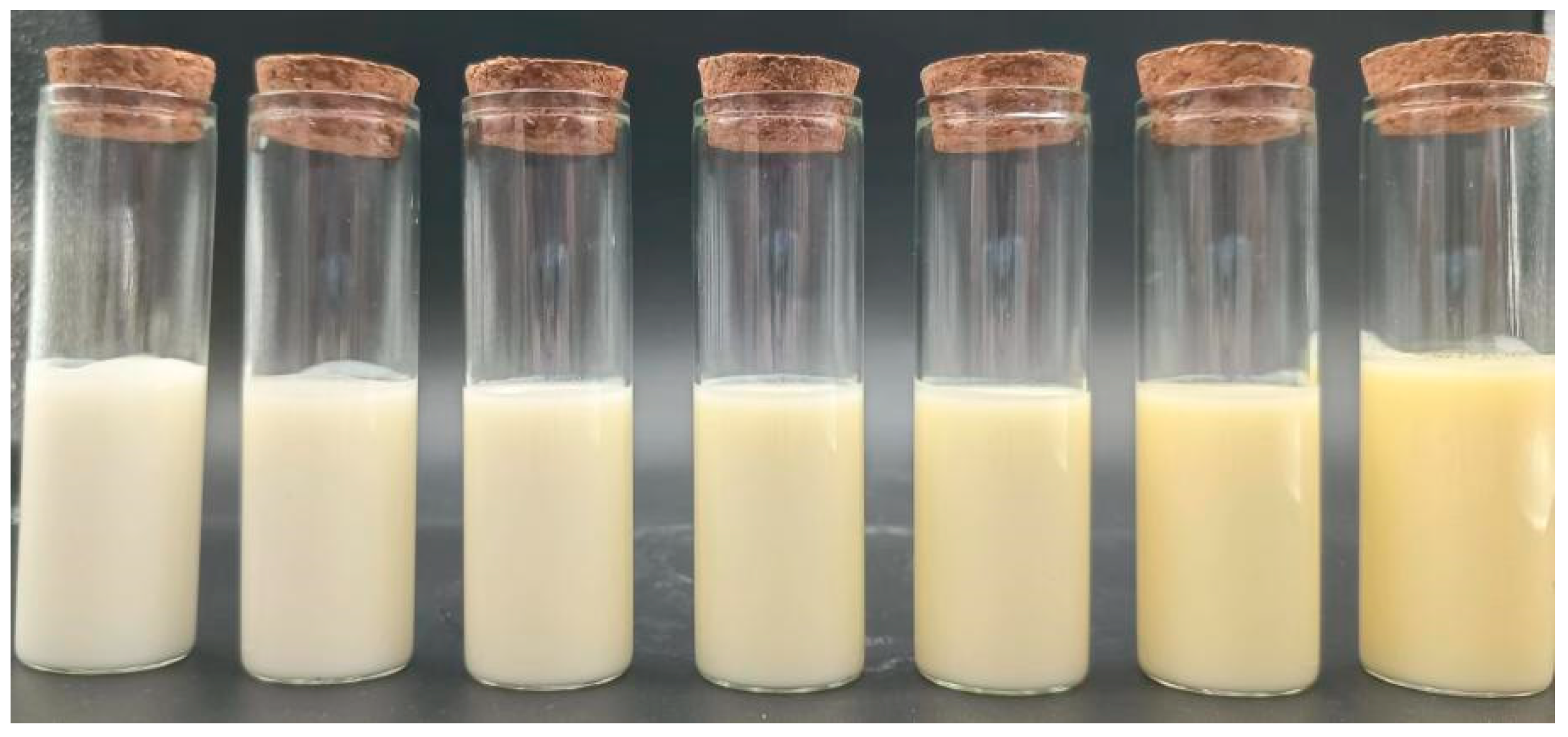
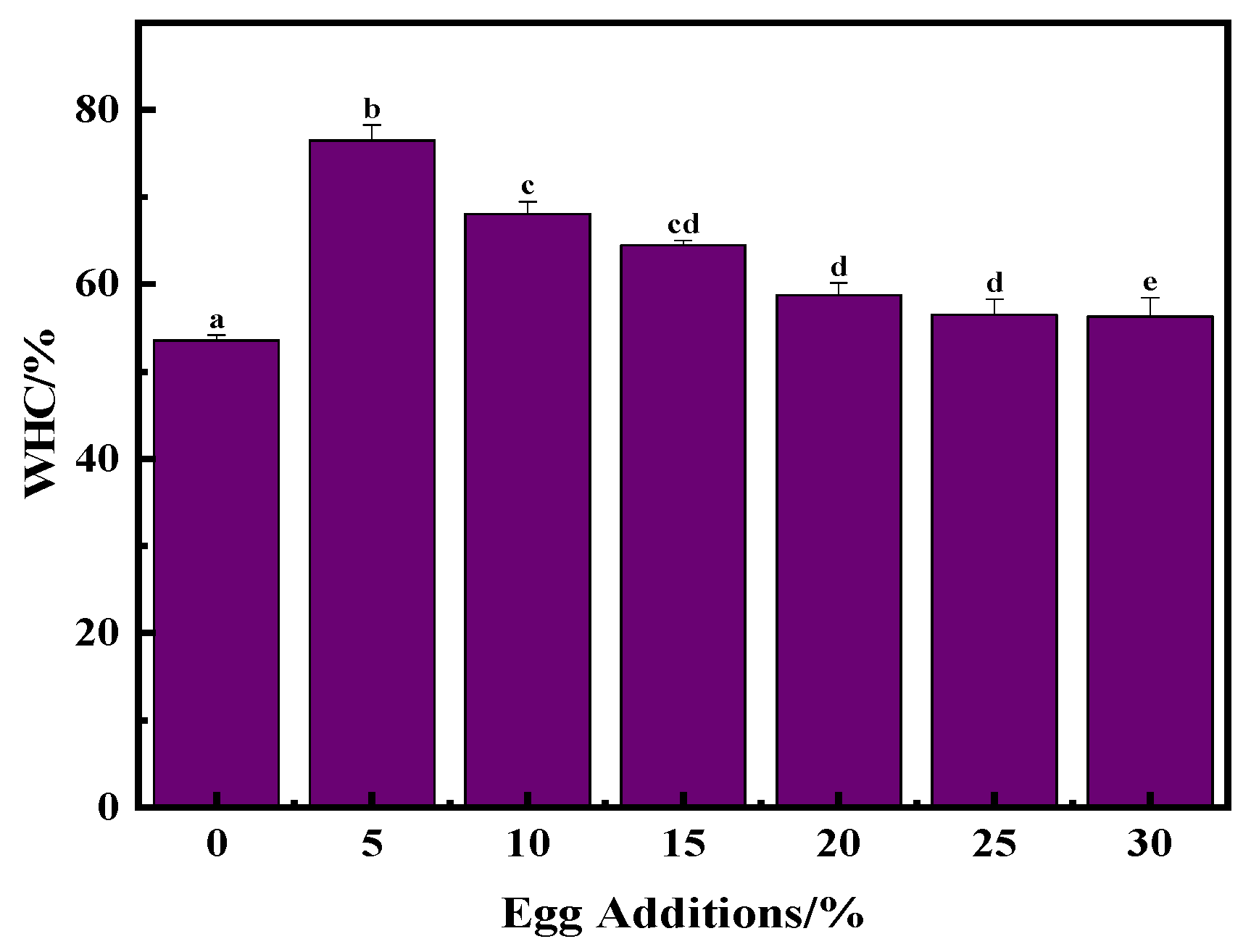

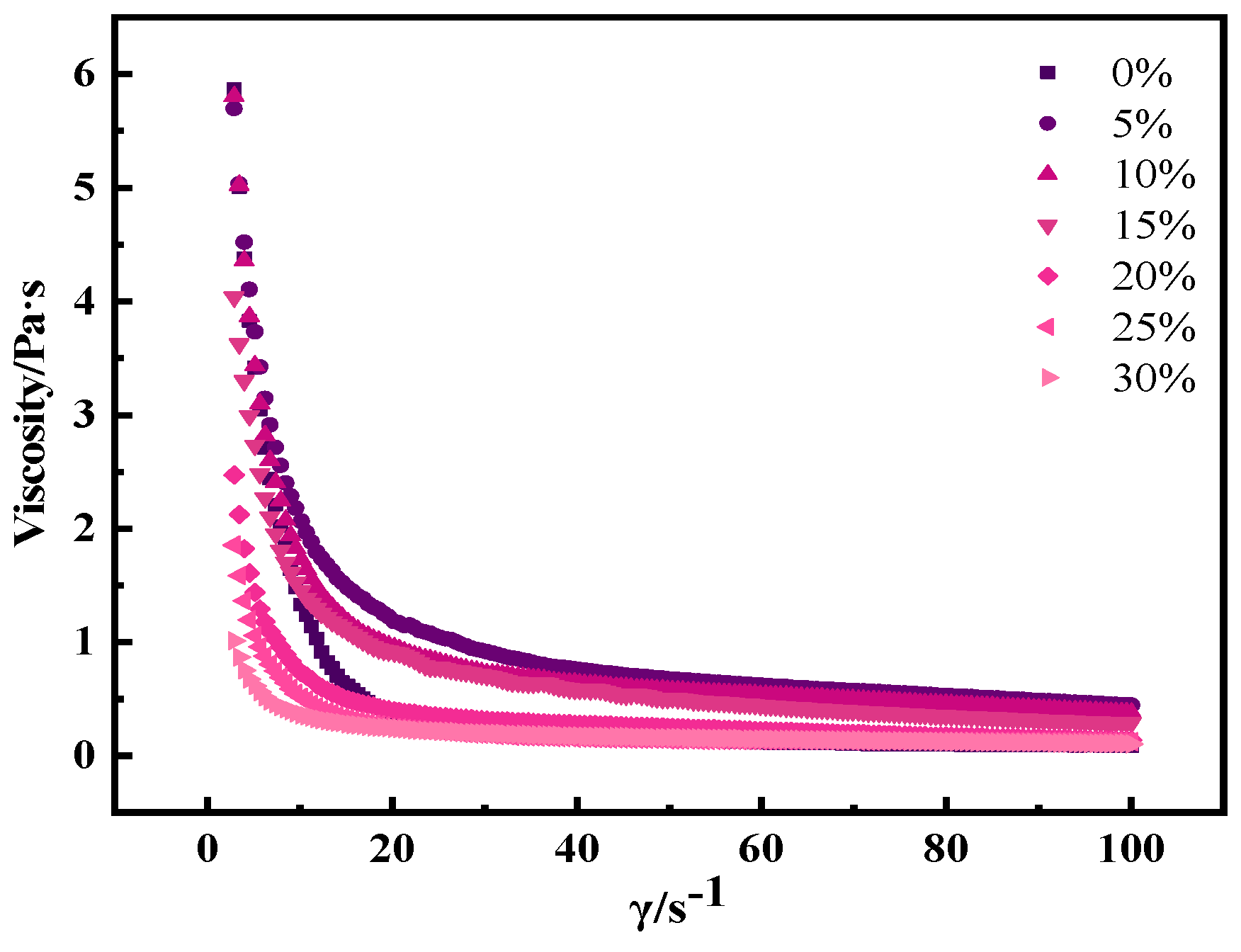

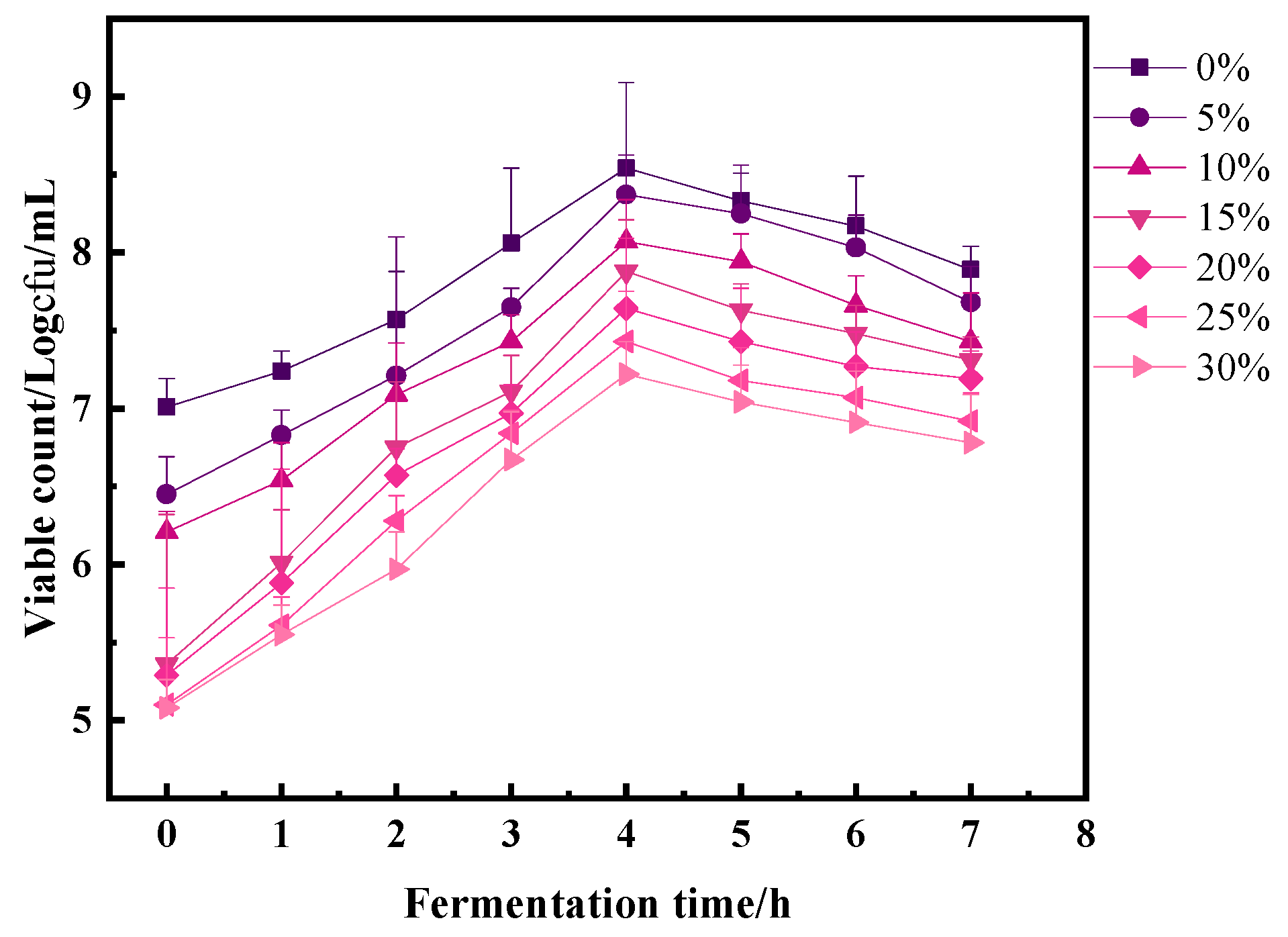
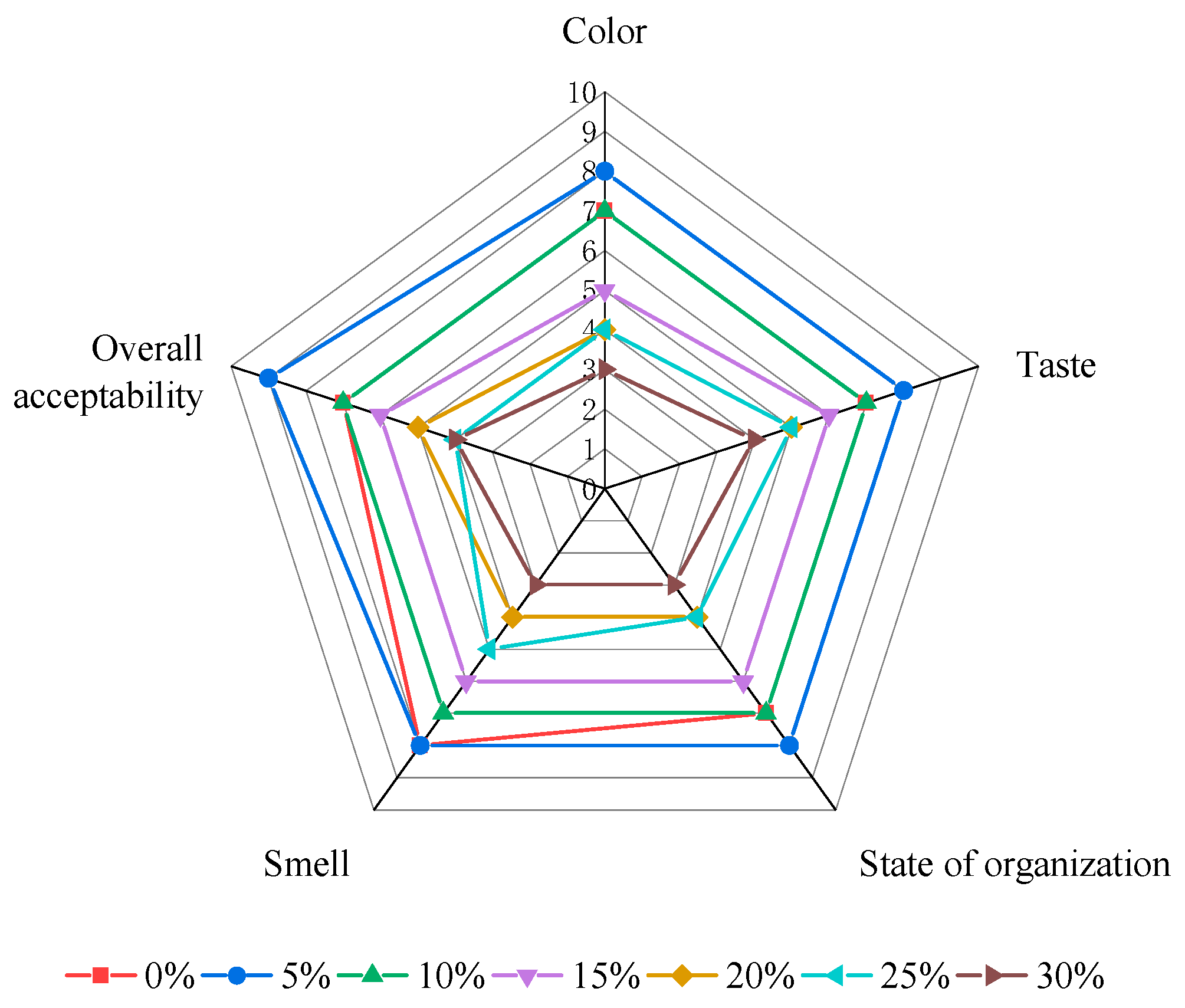
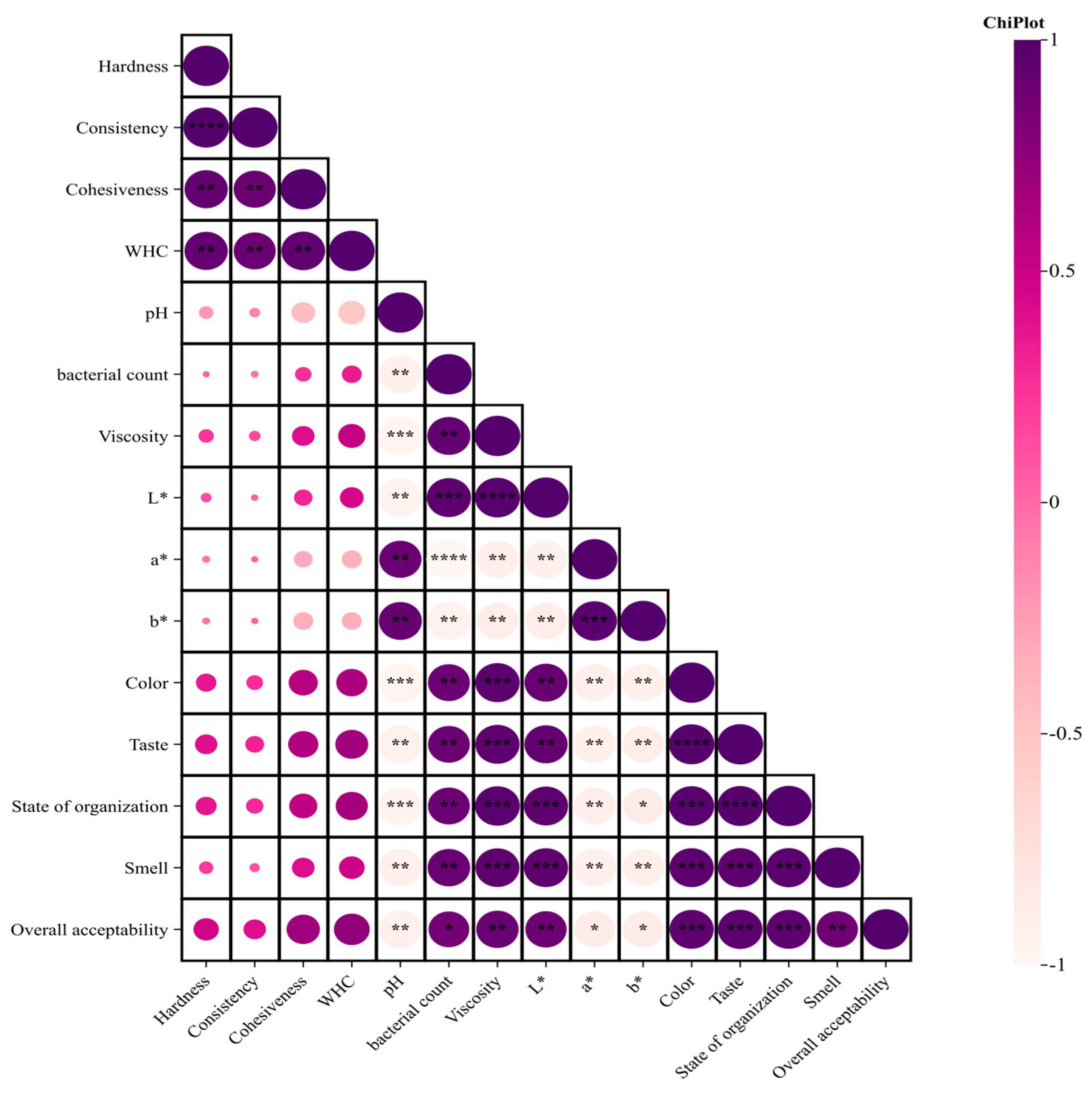
| Evaluation Index | Evaluation Criteria | Total Score (100 Points) |
|---|---|---|
| Color (10 min) | The color is mottled and chromatic | 0~4 |
| The color is more uniform, and the color is better | 5~7 | |
| The color is uniform, and the color is good | 8~10 | |
| Taste (10 points) | The taste is rough and grainy | 0~3 |
| The texture is smooth and light | 4~6 | |
| The taste is fine and not grainy | 7~10 | |
| State of organization (10 points) | There are pores on the surface, and the whey precipitation is obvious | 0~4 |
| There are fewer pores and whey precipitation | 5~7 | |
| No porosity and whey precipitation | 8~10 | |
| Smell (10 points) | There is a distinct odor | 0~3 |
| Lighter odor | 4~6 | |
| The egg aroma is obvious | 7~10 | |
| Overall acceptability (10 points) | Dislike extremely | 0~3 |
| Like | 4~6 | |
| Like extremely | 7~10 |
| Whole Egg Additions | L* | a* | b* |
|---|---|---|---|
| 0% | 101.23 ± 0.34 a | −1.08 ± 0.04 a | 12.74 ± 0.02 b |
| 5% | 99.91 ± 0.03 c | −0.78 ± 0.02 a | 14.35 ± 0.07 a |
| 10% | 99.27 ± 0.39 c | 0.07 ± 0.05 d | 19.95 ± 0.04 d |
| 15% | 98.22 ± 0.16 b | 0.46 ± 0.05 a | 24.52 ± 0.15 a |
| 20% | 94.75 ± 0.53 a | 0.60 ± 0.03 b | 24.88 ± 0.39 b |
| 25% | 93.83 ± 0.09 b | 1.89 ± 0.02 c | 26.17 ± 0.18 a |
| 30% | 92.28 ± 0.24 a | 1.44 ± 0.16 a | 26.93 ± 0.89 c |
| Yogurt Samples | Nutrient Composition | ||||
|---|---|---|---|---|---|
| Proteins (g) | Fat (g) | Carbohydrates (g) | Energy (kJ) | Energy (kcal) | |
| 0% | 3.3 | 3.8 | 9.5 | 362.0 | 85.4 |
| 5% | 7.0 | 3.3 | 4.5 | 320.9 | 75.7 |
| 10% | 8.4 | 3.6 | 4.2 | 351.0 | 82.8 |
| 15% | 9.1 | 4.0 | 4.0 | 374.7 | 88.4 |
| 20% | 10.0 | 4.5 | 4.2 | 412.4 | 97.3 |
| 25% | 11.6 | 4.7 | 5.4 | 467.6 | 110.9 |
| 30% | 12.1 | 5.1 | 6.3 | 506.6 | 119.5 |
Disclaimer/Publisher’s Note: The statements, opinions and data contained in all publications are solely those of the individual author(s) and contributor(s) and not of MDPI and/or the editor(s). MDPI and/or the editor(s) disclaim responsibility for any injury to people or property resulting from any ideas, methods, instructions or products referred to in the content. |
© 2024 by the authors. Licensee MDPI, Basel, Switzerland. This article is an open access article distributed under the terms and conditions of the Creative Commons Attribution (CC BY) license (https://creativecommons.org/licenses/by/4.0/).
Share and Cite
Yang, L.; Wang, L.; Chi, Y.; Chi, Y. Effect of Whole Egg Liquid on Physicochemical, Quality, Fermentation and Sensory Characteristics of Yogurt. Foods 2024, 13, 321. https://doi.org/10.3390/foods13020321
Yang L, Wang L, Chi Y, Chi Y. Effect of Whole Egg Liquid on Physicochemical, Quality, Fermentation and Sensory Characteristics of Yogurt. Foods. 2024; 13(2):321. https://doi.org/10.3390/foods13020321
Chicago/Turabian StyleYang, Lijie, Lifeng Wang, Yujie Chi, and Yuan Chi. 2024. "Effect of Whole Egg Liquid on Physicochemical, Quality, Fermentation and Sensory Characteristics of Yogurt" Foods 13, no. 2: 321. https://doi.org/10.3390/foods13020321
APA StyleYang, L., Wang, L., Chi, Y., & Chi, Y. (2024). Effect of Whole Egg Liquid on Physicochemical, Quality, Fermentation and Sensory Characteristics of Yogurt. Foods, 13(2), 321. https://doi.org/10.3390/foods13020321





